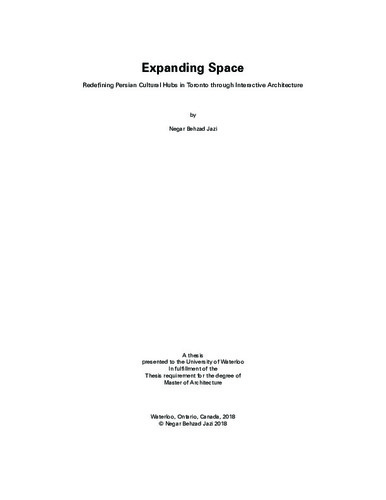UWSpace will be migrating to a new version of its software from July 29th to August 1st. UWSpace will be offline for all UW community members during this time.
Expanding Space: Redefining Persian Cultural Hubs in Toronto through Interactive Architecture
| dc.contributor.author | Behzad Jazi, Negar | |
| dc.date.accessioned | 2018-01-18 16:17:24 (GMT) | |
| dc.date.available | 2018-01-18 16:17:24 (GMT) | |
| dc.date.issued | 2018-01-18 | |
| dc.date.submitted | 2018-01-09 | |
| dc.identifier.uri | http://hdl.handle.net/10012/12881 | |
| dc.description.abstract | Persian communities in Toronto use certain public spaces as a group. One of the less obvious, but interesting, spaces that serve as cultural hubs for these communities are strip malls. These cultural- commercial spaces sometimes act as spaces for political protest or cultural gatherings. This observed use of space was the basis of this thesis and formed the initial thesis question: “how can we start thinking of the strip mall as a public gathering space?” In seeking the answer to this question, there were challenges to face. The nature of strip malls is that they sometimes act as a public space and sometimes as a parking space. In order to expand the public uses of these kinds of hubs, space needs to be shared between cars and people. This thesis therefore seeks to explore a dynamic (interactive) architecture that can be expanded based on the different conditions of the site (strip mall). This thesis aims to study and employ three different elements to create prototypes that have the capacity to expand limited space in this context: the strip mall’s spatial qualities, deployable techniques for creating a dynamic space, and Persian culture. Among several models produced using deployable techniques, two prototypes have been developed as the most appropriate models for expanding the public space in a Persian context. These are the “Market Shell” and “Gathering Shell.” When there is a cultural or social occasion after business hours, these shells activate the strip mall through the functional space that they provide. However, during opening hours, these shells are deactivated to permit the stores and parking area of the strip mall to function. | en |
| dc.language.iso | en | en |
| dc.publisher | University of Waterloo | en |
| dc.title | Expanding Space: Redefining Persian Cultural Hubs in Toronto through Interactive Architecture | en |
| dc.type | Master Thesis | en |
| dc.pending | false | |
| uws-etd.degree.department | School of Architecture | en |
| uws-etd.degree.discipline | Architecture | en |
| uws-etd.degree.grantor | University of Waterloo | en |
| uws-etd.degree | Master of Architecture | en |
| uws.contributor.advisor | Przybylski, Maya | |
| uws.contributor.affiliation1 | Faculty of Engineering | en |
| uws.published.city | Waterloo | en |
| uws.published.country | Canada | en |
| uws.published.province | Ontario | en |
| uws.typeOfResource | Text | en |
| uws.peerReviewStatus | Unreviewed | en |
| uws.scholarLevel | Graduate | en |

